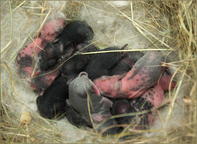Birth and Growing
Rabbit baby management is vital if your business is going to succeed, every baby lost is a youngster that will never be seen as profit. Profit measured as a meal on the table, a future breeding animal or a potential sale rabbit.

Therefore the care of your youngsters is critical. Many breeders leave the litter for a week before a second check. I feel that the nest should be checked once a day, especially if it is a large litter or the first litter for the doe (female rabbit).
Check that the babies are sleek and dry. No ribs should be visible. If the babies look skinny, check the doe by running her hand over her belly. If the mammary glands are hot and swollen she could have mastitis. If the litter has more than 7 or 8 babies the doe might be short of milk.
It is always a good idea to mate more than one doe on any one day. If she is not coping, remove a couple of the babies (take the smallest ones) and while another doe, who is coping well, is distracted with a treat, gently wipe some of the new doe’s scent from under her hutch onto her "foster" babies and place them with the established litter.
Most does will accept foster children easily. If both litters are of the same breed and colour mark the foster babies with a koki pen so that you still know who belongs to which mother. Every time anything changes in the nest, make a note on the hutch card. Babies will start to grow hair on around the 5th day and will open their eyes on around the 8th - 10th day.
It can happen that the eyelids get stuck with mucous. You will see that the eyelids are red and inflamed. Spit on your finger and wipe that spit on the eye and then gently pull the lids apart. This is the best method for fixing ‘nest eye’. Once the eyes are open, the babies will start to move about and might try to follow the doe when she leaves the nest.
Place a brick or ‘step’ in front of the box opening so that they can get back in again. The babies will join the doe to eat solids from about 16 – 21 days. They can eat pellets and all the green feed and hay that their mother has. It is very important that babies have access to water at this stage.
If water is supplied by nipples ensure that they are low enough for the babies to reach. If a dish is used, ensure that it is full and that they cannot fall into the container and drown. Handle the babies, they are the future of your herd and need to be happy with the human touch.